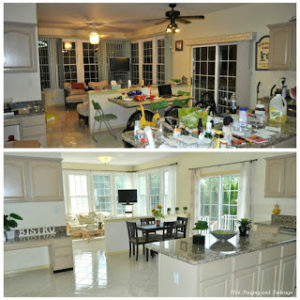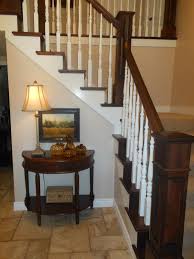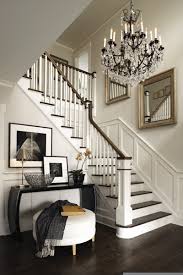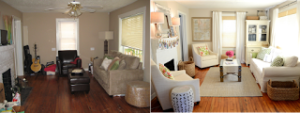By now, most of us have heard about the concept of “staging” a home. Staging a home for the real estate market is all about making it as attractive as possible to potential buyers. A thoughtfully staged home can give you an edge in the competitive world of real estate. It is well worth establishing a plan, dedicating the time and spending the energy to set your home apart from others on the market. However, for me, “staging” goes beyond making a house pretty. It is about creating an experience for potential buyers. You want them to feel an emotional attachment when they leave and to remember your house above all the others.
As a residential interior designer, I am often called upon to help my clients or real estate professionals with this process. Selling a home can be stressful and emotional. Hopefully these few tips will guide you smoothly through the process:
Know your audience and know your competition.
Identifying the demographics of buyers in your area is key to staging your home. Your real estate professional can help you define a profile for potential buyers. Use this information to showcase your home accordingly. Age, income, and stage of life of the potential buyers are all important aspects to consider when staging your home. For example, if the buyer profile include people with children, showcase one of the bedrooms with a child’s theme. If the buyer is a first time buyer, keep the decor simple and attainable. The goal is to have the buyers “see” their selves living there.
Also, take some time to visit other properties on the market in your neighborhood and in your price range. Knowledge of your competition will give you an advantage when staging your home. Use their weak spots to your advantage.
Remove the clutter.
This is a very important step in getting your house ready to go on the market. You want potential buyers to “see” your home and not be distracted by too much clutter. The goal is to showcase your house, not your stuff.
Go through the house with a critical eye. Better yet, hire a professional with fresh eyes, to identify items that need to be cleared out. These items are typically in the kitchen, closets, bathrooms, kid’s rooms, garage and storage closets. Create 3 piles: throw away, donate, and save. Be ruthless. We all have found an unopened box from a previous move tucked away in the basement!
If throwing things away is just too hard for you, consider renting a storage unit for items you cannot part with right away. I especially recommend this to clients that are downsizing.
Bookcases seem to be the primary repository of clutter. This is where photos, old magazines, trophies, keepsakes and painted clay pots from your child’s preschool days seem to land. Bookcases should be neat, not too personal and balanced. A remedy is to clear away half of the “stuff”, keep the hardback books, remove all but a few family photos, display a few good pieces that add interest or color and keep it simple! Less is more.
Create some negative space.
This really means don’t over furnish a room. Be mindful of the furniture placement and only keep key pieces that make sense in the room. Remove pieces that make the room feel small or crowded. It is better to be under furnished than over furnished.
Detach emotionally.
I know, this is easier said than done, but it is important if you are serious about selling your home. Homes have a history and parting can be very emotional. It is nearly impossible to be unbiased about what should stay or go. This is when an outside party, such as your designer or realtor, can really help. Consider their advice and try not to take it personally. Your house will need to appeal to a wide range of people and tastes. So try to let go and appeal to the broadest possible audience.
Think about how people live and how they will use each space.
When showcasing your home, consider how others would live in it and “merchandise” the rooms accordingly. Potential buyers might use spaces differently than you. Keep in mind normal activities such as dining, watching TV, working from home, doing homework, exercising or doing a craft. Allocated areas or rooms to satisfy these functions.
Accentuate the positive.
Identify the areas in your home that have the most appeal and focus on them. Put your best foot forward. Pay attention to any architectural features that make your house unique, such as windows, fireplaces, arches, built-ins or trim details. Accent these areas with paint, accessories or lighting.
Also, remember the foyer sets the tone for the whole house. Make sure it is welcoming and creates a good vibe to all who enter. The foyer is the perfect setting to make a simple statement with artwork, fresh flowers or an interesting piece of furniture.
Consider investing in a few updates.
When putting your house on the market, a few updates are truly worth the investment–especially if it has been a while since the last update. A house that looks dated or stale is a turn off to potential buyers. They see it as a project, feel overwhelmed and move on to the next house.
A few simple improvements can give your home an instant update. In my experience, fresh paint, new light fixtures, updated plumbing hardware and new carpet are all worth consideration. You can see great aesthetic returns on minor improvements.
Window Treatments.
This is a tricky one…if done right, window treatments can do wonders for a room. If done poorly, they will do the exact opposite. Nothing brings a room down like a sad window dressing.
With that in mind, look critically at your existing window treatments and make sure they are enhancing the aesthetics. Elaborate or busy window treatments can make a room feel small, while top-heavy treatments can make the ceiling feel low. Simplify the treatment if necessary.
If the windows offer a pleasing view, draw attention to them. Make sure the treatments frame the windows, without crowding them. This can be achieved by keeping the side panels as far off the windows as possible. Remember, your goal is to sell your house, not your window treatments. If the view is not so special, consider using sheers, natural grass shades or blinds to soften the view.
Replace old or damaged blinds. This is a must! Consider simple wood blinds. They do not offend and look good in almost all decors. If budget is an issue, opt for faux wood blinds. They are lighter, less expensive and look like real wood.
Good quality custom window treatments will increase the value of your home, but again, be sure they are not too heavy. Today there are many good-looking, “ready made” window treatment options on the market. If you go this route, be sure to measure properly and use good quality hardware that is installed correctly. Also, steam or press the panels before you hang them.
Closets and storage areas.
Clear these out as well. (Remember to practice the 3 Piles Method!) Keep items to a minimum and have everything stacked neatly and organized. We all dream of having a perfectly organized linen closet or laundry room. Create one that would make Martha Steward proud. Your potential buyers will remember it!
Hire professional cleaners.
Have your house professionally cleaned the day before it goes on the market or before an open house. This is a treat for you and will make your house shine!
Staging a home can feel overwhelming, but hopefully these few tips will make the process easier for you. Who knows…you might fall in love with your house all over again and decide to stay put!








